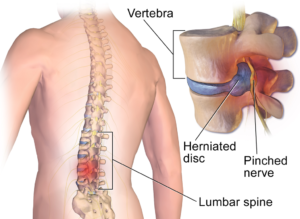Spinal disc problems is one of the least understood issue due to the fact that medical professionals do not agree on the causes of the pain and also because of the plethora of terms used to describe different kinds of spinal disc problems. In this article we would try to demystify and help you understand spine disc better.
What is a Spinal Disc?
Spinal discs are round in diameter and flat on the top and bottom, and are attached securely to the vertebrae above and below them. The discs are somewhat pliant, providing shock absorption for the spine. Because of the many stresses sustained by the spine and changes due to aging, the disc is prone to injury, which in turn can lead to lower back pain, leg pain, and other symptoms such as numbness and weakness.
Root cause of disc problems: Disc Pain and Nerve Root Pain
While there are dozens of terms used to describe disc problems, there really are only two main categories of disc problems: disc pain (degenerative disc disease) and pinched nerve (herniated disc).
Degenerative Disc Disease or Disc Pain
When a patient has a symptomatic degenerated disc (one that causes low back pain and/or leg pain), it is the disc space itself that is painful and the source of pain. This type of pain is typically called axial or referred pain. This condition can occur as part of the aging process in which the discs in the spine start to dry out, thereby losing some of their flexibility and shock absorption. As part of this process, the inner portion of the disc shrinks, providing less cushioning between the boney vertebrae in the spine, and the outer part of the disc can suffer small tears, all of which can cause pain.
Herniated Disc or Pinched Nerve

When a patient has a symptomatic herniated disc, the disc itself is not painful, but rather the material that is leaking out of the inside of the disc is pinching or irritating a nearby nerve. This type of pathology produces pain called radicular pain (e.g., nerve root pain) leading to pain that may radiate to other parts of the body, such as from the low back down the leg or from the neck down the arm. Leg pain from a pinched nerve is usually described as sciatica.
The pain and other symptoms, such as numbness, tingling, or weakness, typically travels along the path of the nerve, so that a disc that herniates in the lower part of the spine causes pain along the sciatic nerve through the back of the leg, and a disc that herniates in the cervical spine causes pain that radiates through the arm.
Regardless of what the disc problem is called - a slipped disc, bulging disc, degenerated disc, etc. - it is most important for the patient to understand if the pain is being caused within the disc itself, or if it is pain along the nerve root.
An accurate diagnosis of the cause of the patient's pain is needed to determine the appropriate treatment options.
If you or someone you know if dealing with disc pain or problem, book an appointment with us today. Our physiotherapists will asses your situation and recommend you a treatment plan that helps you get freedom from pain.


